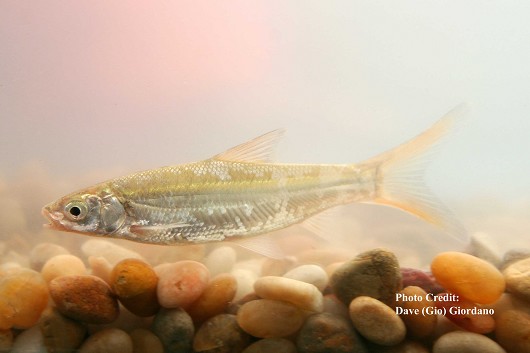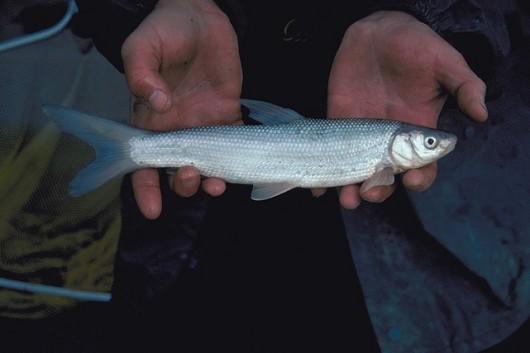Sacramento Splittail
-
Scientific NamePogonichthys macrolepidotus
-
NativeNative Species
-
Identification
 Sacramento splittail, juvenile , approximately 10 cm (4”) long. Location: Suisun Marsh, California. Date: 8/6/2007.
Sacramento splittail, juvenile , approximately 10 cm (4”) long. Location: Suisun Marsh, California. Date: 8/6/2007. Sacramento splittail, adult, from the Cosumnes River, CA. Photo courtesy of Professor Peter B. Moyle.
Sacramento splittail, adult, from the Cosumnes River, CA. Photo courtesy of Professor Peter B. Moyle.- Large minnow, to over 40 cm SL
- Oversized upper lobe of caudal fin, elongate body, adults with hump
- Slightly sub-terminal mouth, barbels present at margins
- Hooked pharyngeal teeth, tiny inner-tooth row
- Coloration: silver, fading with age, dusky olive gray back
- Breeding adults: caudal, anal, dorsal, and paired fins have red-orange tinge
- Breeding males: darker than normal, white tubercles on head and bases of fins
- Fin rays: dorsal 9-10, pectoral 16-19, pelvic 8-9, anal 7-9
- Lateral line scales: 57-64
-
Life History
Sacramento splittail are hearty minnows that live in fluctuating environments and can tolerate relatively high salinities and low oxygen levels (< 1.0 mg/L). Typically they are found in estuarine environments and are commonly found in water with salinities from 10-18 ppt. They prefer slightly lower salinities but can survive short term exposures to water with a salinity as high as 29 ppt. Splittail are usually found where water temperatures range from 5-24°C, though under laboratory conditions they have shown an ability to survive short exposures to temperatures as high as 33°C. These adaptations make splittail well suited for slow moving rivers, sloughs, and alkaline lakes. Sacramento splittail feed on bottom dwelling invertebrates and detritus in low to moderate currents. Young splittail focus their feeding on benthic crustaceans and they show an ability to swim against strong tides and currents. In the Sacramento-San Joaquin Delta splittail feed opportunistically during the day with peak feeding early in the morning. Prey items include clams, crustaceans, insect larvae, and other invertebrates. During high flows they may enter the floodplain where they feed on earthworms. In the Suisun Marsh opossum and then mysid shrimp have been focal points of feeding for the splittail. Sacramento splittail live relatively long lives of up to 5-7 years, possibly longer. Females live longer than males and reach greater total lengths. Splittail typically reach sexual maturity by the end of their second year (around 170 mm SL). Males may mature in their first year (110 m SL) while females may not mature until their third year (215 mm SL). After their third year splittail grow an average of 35 mm/year for the remainder of their life. During winter and spring adult splittail move upstream to forage and later spawn between late February and early July. Spawning is presumably triggered by day length, increased flows, and water temperatures rising to a range of 14-19°C. Spawning occurs in flooded vegetation with older fish spawning first. Peak reproduction occurs in March and April though splittail are fractional spawners, so the process may take months. Typically egg production increases with body size and one large female may produce over 100,000 eggs. Fertilized eggs stick to the flooded vegetation till the embryos hatch 3-7 days later. Hatch time is temperature dependent. Active feeding and swim bladder function in the larvae begins 5-7 days after the hatch. The larvae remain in the vegetation for 10-14 days where they have adequate cover and access to small prey. Young-of-year splittail move into the estuary in April-August where they occupy water less than 2 m deep.
-
Links to Other ResearchN / A
-
Watershed
-
Coyote Watershed
-
Lower American Watershed
-
Lower Bear Watershed
-
Lower Feather Watershed
-
Lower Sacramento Watershed
-
Lower Yuba Watershed
-
Middle San Joaquin-Lower Chowchilla Watershed
-
Middle San Joaquin-Lower Merced-Lower Stanislaus Watershed
-
Sacramento-Stone Corral Watershed
-
San Joaquin Delta Watershed
-
San Pablo Bay Watershed
-
Suisun Bay Watershed
-
Please note, watersheds are at the USGS 8-digit Hydrologic Unit Code (HUC) scale, so they often include a lot of sub-watersheds. If a species occurs in any sub-watershed within the HUC, the species appears within the HUC. Link to an EPA page that shows HUCs.

